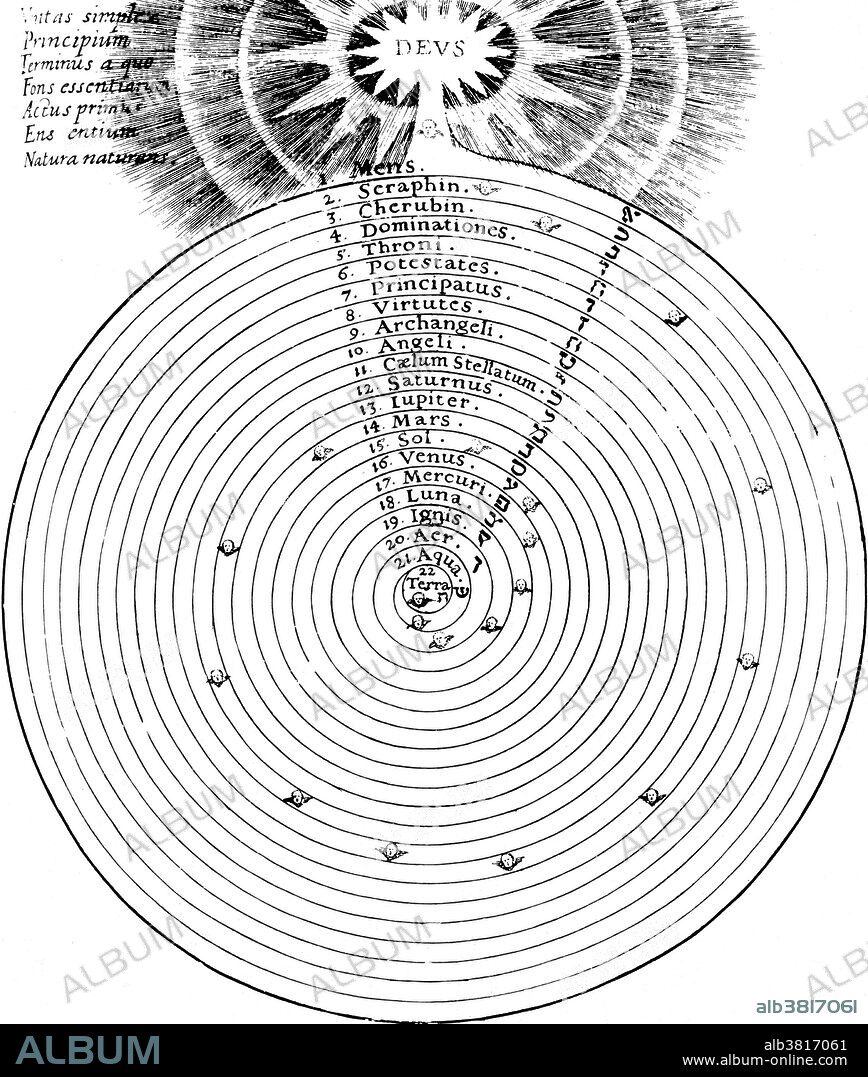alb3817061
Aristotlelian and Christian Cosmologies Merge

|
Add to another lightbox |
|
Add to another lightbox |



Buy this image.
Select the use:

Title:
Aristotlelian and Christian Cosmologies Merge
Caption:
Historical diagram illustrating the grafting of Aristotelian theory onto the Christian version of the cosmos. Aristotle (384-322 BC) developed an early model of the cosmos based on the concept of uniform circular motion. To account for the motions of the stars, sun, moon, and the five known planets, his model used 56 spherical shells each centered on the earth. These shells were divided into two regions: the realm of change near the earth and the eternally unchanging heavens. The realm of change consisted of spheres of each of the four classical elements: earth, water, air, and fire. The heavens were made of an unchangeable, transparent material called the ether. Due to the influence of Albertus Magnus and Thomas Aquinas Aristotle's cosmology became an integral part of the Catholic faith. In the 13th century his primum mobile was identified with god himself thus losing its astronomical value in favor of moral and religious reasoning. The cosmos were peopled with celestial figures who interceded between man and god.
Category:
black & white • Science: History
Credit:
Album / Science Source / New York Public Library
Releases:
Image size:
3010 x 3549 px | 30.6 MB
Print size:
25.5 x 30.0 cm | 10.0 x 11.8 in (300 dpi)
Keywords:
AARE FIRE • AGUA • AIR • ALBERTUS MAGNUS • ANGELI • ANGELS • ANGELS, SERAPHIM • APHRODITE • ARCHANGELI • ARCHANGELS • ARISTOTELIAN • ARISTOTLE • ART • ARTWORK • ASTRONOMIA • ASTRONOMICAL • ASTRONOMY • BLACK & WHITE • BW • CATHOLIC • CELESTIAL BODY • CELESTIAL OBJECT • CENTER OF THE UNIVERSE • CENTER • CHERUBIM • CHERUBIMS • CHRISTIAN INFLUENCED • CHRISTIAN • COSMOLOGICAL • COSMOLOGY • COSMOS • DIAGRAM • DOMINATIONS • DOMINICANS • DRAWING • EARTH • FAITH • GRAFTING • HEAVENLY BODY • HEAVILY BODIES • HISTORIC • HISTORICAL • HISTORY • IGNUS • ILLUSTRATION • ILLUSTRATIONS • ILUSTRATION • IMPORTANT • INTEGRAL • JUPITER • LUNA • MARS • MERCURI • MERCURY • MERGING • MOON • MORAL • POWERS • PRIMUM MOBILE • PRINCIPALITIES • RELIGION • RELIGIOUS • SATURN • SATURNUS • SCIENCE • SCIENCE: HISTORY • SERAPHIM • SERAPHS • SOL • SPHÈRE • SPHERICAL • SUN • TERRA • THEORY • THOMAS AQUINAS • THRONES • UNIFORM CIRCULAR MOTION • VENUS • VENUS; • VIRTUES • VIRTUTES • WATER • WEDDING • ZEUS
 Pinterest
Pinterest Twitter
Twitter Facebook
Facebook Copy link
Copy link Email
Email
